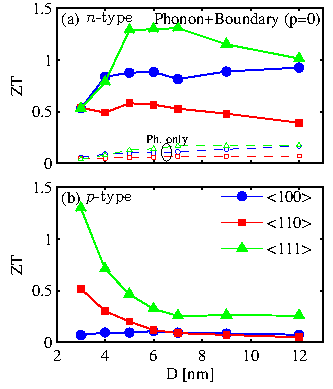
|

|
This improvement in the power factor further proves the point that boundary
scattering is more effective in reducing the thermal conductivity than reducing the power
factor. As a result, phonon engineering techniques that cause additional reductions in the
thermal conductivity could provide improvements of ![]() , despite the consequent reduction in the electrical conductivity. For example, in the case of a fully
diffusive boundary for phonons, either by special engineering of the roughness [148,149,21], by decorating the surfaces with various species [150,59,151], or by modulating the nanowire's diameter [124], the
, despite the consequent reduction in the electrical conductivity. For example, in the case of a fully
diffusive boundary for phonons, either by special engineering of the roughness [148,149,21], by decorating the surfaces with various species [150,59,151], or by modulating the nanowire's diameter [124], the ![]() performance could be increased. This is illustrated in Fig. 6.5, showing
performance could be increased. This is illustrated in Fig. 6.5, showing ![]() for the same nanowires as before in Fig. 6.3, but now we assume a fully diffusive boundary for phonons, e.g. the specularity parameter is set to
for the same nanowires as before in Fig. 6.3, but now we assume a fully diffusive boundary for phonons, e.g. the specularity parameter is set to ![]() for all wavevectors. In this case,
for all wavevectors. In this case, ![]() is increased to values close to
is increased to values close to
![]() for both
for both ![]() -type and
-type and ![]() -type nanowires (in the best cases). This is almost a factor of
-type nanowires (in the best cases). This is almost a factor of
![]() improvement compared to the case we present in Fig.6.3 where we employ the
improvement compared to the case we present in Fig.6.3 where we employ the ![]() -dependent specularity parameter
-dependent specularity parameter ![]() , rather than fully diffusive boundaries for all phonons.
, rather than fully diffusive boundaries for all phonons.